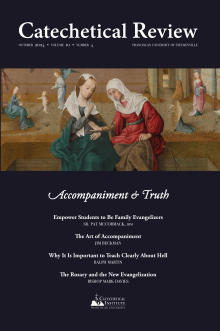 In his apostolic exhortation Evangelii Gaudium (“The Joy of the Gospel”), Pope Francis urged the Church to practice the “art of accompaniment.”[1] But what does this mean, and how do we do it? As others have noted, we have a model of accompaniment in our Lord’s appearance on the road to Emmaus (Lk 24:13–35).[2] When the two disciples were walking away from Jerusalem, their hopes dashed at the foot of the Cross, Jesus accompanied them on the way: he listened to them, he asked questions, and, eventually, he challenged them and shared the Gospel with them.
In his apostolic exhortation Evangelii Gaudium (“The Joy of the Gospel”), Pope Francis urged the Church to practice the “art of accompaniment.”[1] But what does this mean, and how do we do it? As others have noted, we have a model of accompaniment in our Lord’s appearance on the road to Emmaus (Lk 24:13–35).[2] When the two disciples were walking away from Jerusalem, their hopes dashed at the foot of the Cross, Jesus accompanied them on the way: he listened to them, he asked questions, and, eventually, he challenged them and shared the Gospel with them.
What does this mean for us catechists, priests, and teachers who sometimes meet people who are disillusioned and moving “away from Jerusalem”—away from Christian life? How can we help them? Where do we start? Like Christ on the road to Emmaus, we accompany them: we meet them where they are, we enter their lives, we listen to them, and we ask them questions. But also, like Christ, we accompany them toward a destination, so that, with minds enlightened and hearts set aflame by the Gospel, they may “return to Jerusalem” and live in the power of Christ’s Resurrection. Thus, Christian accompaniment requires a clear sense of our “destination,” and, in particular, a clear understanding of the nature of Christian faith.
In what follows, I briefly outline the nature of Christian faith (as distinguished from “natural faith”), describe its grandeur and demands, and offer some consequences for our ministry.
The rest of this online article is available for current Guild members.
[1] Pope Francis, Evangelii Gaudium, no. 169; see further nos. 169–73.
[2] See, for example, Bob Rice, “Listening and Accompaniment,” Catechetical Review 4, no. 4 (October–December, 2018): 42.
[3] Cf. Congregation for the Doctrine of Faith, Dominus Iesus, no. 7: “the distinction between theological faith and belief in the other religions, must be firmly held.”
[4] See Thomas Aquinas, Summa Theologiae [ST] II–II, q. 1, a. 1.
[5] An old Act of Faith prayer expresses this well: “My God I believe in thee, and all thy Church doth teach, because thou hast said it, and thy word is true.”
[6] See ST II–II, q. 17, a. 6.
[7] Explaining St. Thomas Aquinas’ exegesis of Heb 11:1, Benedict XVI wrote: “through faith, in a tentative way, or as we might say ‘in embryo’—and thus according to the ‘substance’—there are already present in us the things that are hoped for: the whole, true life. And precisely because the thing itself is already present, this presence of what is to come also creates certainty: this ‘thing’ which must come is not yet visible in the external world (it does not ‘appear’), but because of the fact that, as an initial and dynamic reality, we carry it within us, a certain perception of it has even now come into existence.” Spe Salvi, no. 7.
[8] This firmness of faith doesn’t preclude questions and even the feeling of darkness—consider the life of Mother Teresa of Calcutta or St. Thérèse—rather, firm faith means clinging to God, who is with you in the darkness.
[9] See ST II–II, q. 5, a. 3.
[10] See ibid. Note the qualifier of “obstinacy”—God alone knows the culpability of someone’s unbelief, and, as Fulton Sheen noted, many of those who reject Catholic doctrine actually only reject what they think the Church teaches, which is often very different from Catholic doctrine. Many who reject Catholic faith, therefore, reject a caricature of it without ever having heard a morally compelling explanation of the truths of faith; thus, much unbelief may not be “obstinate” unbelief. Cf. Pope Francis’ encouragement for pastoral prudence and charity in this regard in Evangelii Gaudium, no. 44.
[11] Cf. Pope Francis, Evangelii Gaudium, nos. 36–39, 164.
[12] Recall the sinful woman in Luke 7:47, who showed great love in response to having received great mercy: “So I tell you, her many sins have been forgiven; hence, she has shown great love. But the one to whom little is forgiven, loves little.”
This article originally appeared on pages 54-59 of the print edition.
Art Credit: St. Augustine of Hippo receiving the Most Sacred Heart of Jesus, painting by Philippe de Champaigne, 17th Century, Wikimedia Commons.
This article is from The Catechetical Review (Online Edition ISSN 2379-6324) and may be copied for catechetical purposes only. It may not be reprinted in another published work without the permission of The Catechetical Review by contacting [email protected]

















